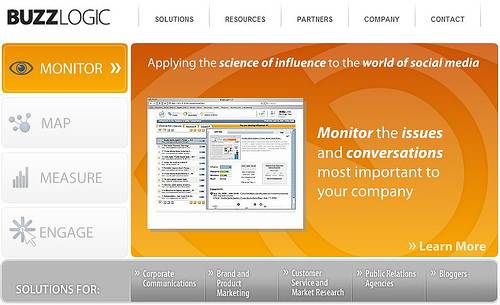BuzzLogic was one of the hits of the
recent DEMOfall 06 event. As Alex Iskold noted in his
original post about the company, its software helps marketers track social
influence among blogs and other web sites. We were as intrigued by BuzzLogic as
everyone else, so Alex Iskold followed up with Mitch Ratcliffe to find out more.
In this interview we discover that Mitch co-founded the company in early 2004
“in order
to find automated ways of analyzing influence.” So it’s been a long journey to launch – read on to find out how it got to this point and what we can expect in the future from BuzzLogic.

R/WW: What is your company about?
We’re seeking influencers in conversational markets, giving them more power
and marketers better insight into how to deploy their limited resources to deal
with the explosion of incredibly specific feedback that companies, organizations and
political campaigns are receiving through social media. The tools we’re building
will be applied to many of the challenges we talk about with social media, such
as valuing individual contributions to the conversation, rather than just traffic
– and how to interact through a dynamic personal form of communication in order to
get the results you aim for.
R/WW: Why did you start this company?
It actually began with a question about how to deal with a blogger, from a
friend who is the CEO of a public company. I found myself drawing maps to
explain not just the connectedness of a blogger to others in the market, but the
way that a blog’s influence varies from topic to topic. It was a short step from
that to deciding, with Todd Parsons, to start the company in early 2004 – in order
to find automated ways of analyzing influence.

Basically, I was doing something with those maps that is analogous to
building a spreadsheet with pen and paper. There had to be a technological
solution to gathering the data and a methodology for processing it into
meaningful insight. We started by drawing maps with a project called MyDensity,
which let bloggers display a fairly rudimentary social map around their blogs.
It got some traction, but we ran through our crawling/hosting capacity without
coming up with a business model to support it. That quickly evolved into a
business built on providing much more detailed data to paying customers, since
the backend processing was awfully expensive. We’ve always been focused on
actually building a business, which is why we brought on a team and CEO Rob
Crumpler, all who worked for next to nothing while we made progress toward the
launch.
Now, the company has built an infrastructure that is both more powerful and
much more efficient – so we are able to launch our first product, which is a
hosted influence monitoring and tracking service that combines our analysis with
tools for interacting with influencers, so that marketers can measure the
results.
R/WW: What are you major accomplishments thus far?
Well, we launched. The backend is built on a solid index and patent-pending
analytics that produce really useful information. The initial feedback from our
launch at DEMO was very positive, especially with regard to how we display
information and the UI that customers use to manage their interactions in
conversational markets. That was particularly satisfying for everyone at
BuzzLogic, because it would be easy to ship something that only managed to add
noise rather than increasing signal in these incredibly active social networks.
R/WW: What are your major challenges?
Handling the growing amounts of data flying back and forth over blogs,
mainstream media and all the others sites people talk about, particularly the
false information generated by splogs. Our engineers have developed some really
clever approaches to identifying spam, so our index is very clean. But, there’s
a paradoxical problem, too, in that sometimes what appears to be noise can be
orchestrated to have an impact on how people find and come to perceive
information, so we have to keep the spam in context to provide customers some
warning if splogs begin to reshape sentiment about their product or brand.
Then there is the problem of scaling the index for performance and growing
customer demand, the usual challenges for a Web service. The beauty of these
challenges is that every time we overcome one, a new market for our data appears.
R/WW: What are you going to build in the next 12 months?
Lots more cool stuff, especially some tools for bloggers to use to understand
and act on the market around them – and to tap into the value they are creating.
Our marketing and PR tools will be substantially enhanced, drawing in more data
from specialized sources that shape conversations, as well.
R/WW: What is the most important thing for a start up to be successful?
Hydration. You need to keep the fluids coming to everyone on the team. After
that, it’s all about trusting people to do their best and tolerating the cost of
people learning, because the sum of those experiences is greater insight into
the thing you want to build.
R/WW: What web sites / blogs do you use / read often?
Blogs:
Fred Wilson’s A VC
Alex Barnett
Another World is Here
Bubblegeneration
Confused of Calcutta
Doc Searls
Ethan Zuckerman
Brad Feld
if:book
Greater Democracy
Battelle’s SearchBlog
John Robb
Mashable
Read/Write Web
ResearchBuzz
Reverse Cowgirl’s Blog
Seth Goldstein’s Transparent Bundles
Nick Carr
Scoble
ZeFrank
Sites:
Baseball Prospectus
CNET
Economist
Nature
New York Times
Washington Post
Tacoma News Tribune
Techmeme
ZD Net
R/WW: Which web 2.0 things are noise and which are signals?
I’m discinclined to celebrate the Ajaxification or Rubification of existing
functionality, so the announcement of a drag-and-drop feature in an Ajax office
app is just noise – because that feature isn’t going to differentiate the product
from its desktop predecessors.
Signal is taking something new and turning it
into something practical and surprising. I don’t think a lot of people agree
with the one I was surprised by at DEMO, but Cuts – which lets people create edit
paths through media, including DVDs and television shows, and share those edit
paths through a community – was a big signal for me, because it shows how people
can route around dumb industries by passing instructions for using products
created by intransigent industries, from person to person.










